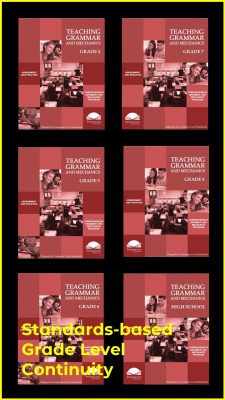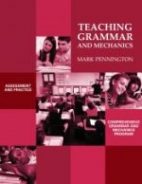
Mechanics Quiz for Teachers
See how much you know about mechanics (commas, capitalization, quotation marks, colons, apostrophes, semicolons, punctuation, etc.) by taking the 10 Question Mechanics Quiz for Teachers. Don’t worry; I’ll dispense with the usual “If you score 9 or 10 out of 10, you are…” Let’s keep things fun! Take out a pen and some scratch paper. Number from 1‒10.
I selected quiz items from the grades 4‒8 Common Core Anchor Standards for Language.
CCSS.ELA-LITERACY.L.7.2

Common Core Anchor Standards for Language
Demonstrate command of the conventions of standard English capitalization, punctuation, and spelling when writing.
Note: The Common Core authors call these components language conventions (along with Standard 1 grammar). Helpful links follow each question if you want to learn explore the grammatical topics.
The answers to the multiple-choice questions follow my promotional materials to ensure that you glance at my grammar and mechanics programs. Okay, so you’re probably not going to get all of these answers correct. I’m sure it’s just the way I’ve phrased the questions and/or answers. I would be happy to explain any of the distractors. Comments are welcomed (not welcome).
Mechanics Quiz for Teachers
1. According to the serial (Oxford) comma rule, which sentence is incorrectly punctuated?
A. Rafael, Louis and Tom met Luisa and Pablo at the coffee shop.
B. Choose the desk, table, or the huge, ugly chair for your apartment.
C. The bright morning sky, cool breeze, and warm company improved my mood.
D. I like most breeds of small dogs, but prefer cats, birds, and hamsters as pets.
https://blog.penningtonpublishing.com/grammar_mechanics/the-serial-oxford-comma-for-the-want-of-a-nail/
2. According to compound sentence comma rules, which sentence is correctly punctuated?
A. Do you want donuts, or would you prefer scones?
B. Although frequently attacked by her critics, Alyssa continued to press for change.
C. I met Allen and we biked through the park.
D. The teacher was available from noon until three yet neither Jesse, nor Holly, wanted help.
http://grammartips.homestead.com/compoundsentences.html
3. According to introductory phrase comma rules, which sentence is incorrectly punctuated?
A. Through snow and sleet the postal carrier slogged the mail to our houses.
B. Compared to Mike, Huang, and Emily, the other students were quite prepared.
C. Tall and tan, the young man bore a striking resemblance to the actor.
D. Under my bed, I hid my baseball card collection.
https://owl.english.purdue.edu/owl/resource/607/03/
4. According to dependent (subordinate) clause comma rules, which sentence is correctly punctuated?
A. Whichever you choose, is fine with me. B. Since you left, he has never been the same though he has received constant care.
C. I still received excellent service in spite of the delays. D. Even though, she was ready on time, Suzanne still missed the appointment.
https://www.khanacademy.org/humanities/grammar/punctuation-the-comma-and-the-apostrophe/commas-in-space-and-time/v/commas-and-introductory-elements-the-comma-punctuation-khan-academy
5. According to proper noun capitalization rules, which sentence is incorrectly punctuated?
A. Marvin “The Shark” Bentley had been brought up on racketeering charges by the District Attorney.
B. He was interrogated by the Federal Bureau of Investigation twice during the Cold War.
C. The U.S. Constitution specifies “High Crimes And Misdemeanors” as grounds for impeachment in Article 1, Section 2, Clause 5.
D. I saw the President of the United States speak at the Capitol on the Fourth of July.
https://www.quickanddirtytips.com/education/grammar/capitalizing-proper-nouns
6. According to abbreviation and acronym rules, which sentence is correctly punctuated?
A. David has worked outside of the U.S. in many foreign countries, but he now works for NASA.
B. Ms. Jennifer Jenkins, MD, went AWOL from Dr. Master’s practice.
C. Ikeda awoke to the screaming alarm at 6:00 A.M.
D. She earned her MA in Curriculum Development at U.C.L.A.
https://dictionary.cambridge.org/grammar/british-grammar/about-words-clauses-and-sentences/abbreviations-initials-and-acronyms
7. According to quotation rules, which sentence is incorrectly punctuated?
A. I want to read the final chapter, “Return of the King,” before I go to sleep.
B. In The Declaration of Independence, did Jefferson say “…all men are created equal?”
C. He asked, “What did Dr. King mean in the ‘I Have a Dream’ speech by the phrase ‘free at last’?”
D. “Blowin’ in the Wind” was released on the 1963 album, Freewillin’ Bob Dylan.
https://blog.penningtonpublishing.com/grammar_mechanics/22-quotation-mark-rules/
8. According to apostrophe rules, which sentence is correctly punctuated?
A. The wives’ dinner at the Jones’ place, followed by dessert at the Martins, showed off the women’s best recipes.
B. Bob and Jolene’s recipe was more popular than her’s.
C. Ethan and Mary’s reactions to the business proposal were quite different.
D. Charles’ books were found on the bookshelves at the Sanchez’s.
https://owl.english.purdue.edu/owl/resource/621/01
9. According to semicolon rules, which sentence is incorrectly punctuated?
A. All their work was wasted; the fund was depleted; and they had no future prospects.
B. Desmond asked for more than his fair share; Mark wondered why the paint would not dry.
C. She did absolutely none of the work; I did it all.
D. Dexter spent time in Chico and Redding in Northern California; El Cajon and San Diego in Southern California; and Visalia and Merced in Central California.
http://www.grammar-monster.com/lessons/semicolons_in_lists.htm
10. According to colon rules, which sentence is correctly punctuated?
A. His list of accomplishments include: a marathon time of 4:25:34, a key to the city, and a blue ribbon at the Alabama State Fair.
B. I loved listening to “The Great Adventure: landing on the Moon” on my new phone.
C. The politician outlined three goals: A tax on steel imports, a single-payer health care system, and a higher minimum wage.
D. A whale is not a fish: nor is it a crustacean.
https://www.grammarly.com/blog/colon-2/
Want to take the 10 Question Grammar Quiz for Teachers? Check it out after you self-correct your mechanics quiz.
Answers: 1. A 2. D 3. D 4. C 5. A 6. A 7. B 8. A 9. B 10. C
*****

Pennington Publishing Grammar Programs
Teaching Grammar, Usage, and Mechanics (Grades 4, 5, 6, 7, 8, and High School) are full-year, traditional, grade-level grammar, usage, and mechanics programs with plenty of remedial practice to help students catch up while they keep up with grade-level standards. Twice-per-week, 30-minute, no prep lessons in print or interactive Google slides with a fun secret agent theme. Simple sentence diagrams, mentor texts, video lessons, sentence dictations. Plenty of practice in the writing context. Includes biweekly tests and a final exam.
Grammar, Usage, and Mechanics Interactive Notebook (Grades 4‒8) is a full-year, no prep interactive notebook without all the mess. Twice-per-week, 30-minute, no prep grammar, usage, and mechanics lessons, formatted in Cornell Notes with cartoon response, writing application, 3D graphic organizers (easy cut and paste foldables), and great resource links. No need to create a teacher INB for student make-up work—it’s done for you! Plus, get remedial worksheets, biweekly tests, and a final exam.
Syntax in Reading and Writing is a function-based, sentence level syntax program, designed to build reading comprehension and increase writing sophistication. The 18 parts of speech, phrases, and clauses lessons are each leveled from basic (elementary) to advanced (middle and high school) and feature 5 lesson components (10–15 minutes each): 1. Learn It! 2. Identify It! 3. Explain It! (analysis of challenging sentences) 4. Revise It! (kernel sentences, sentence expansion, syntactic manipulation) 5. Create It! (Short writing application with the syntactic focus in different genre).
Get the Diagnostic Grammar, Usage, and Mechanics Assessments, Matrix, and Final Exam FREE Resource:

Get the Grammar and Mechanics Grades 4-8 Instructional Scope and Sequence FREE Resource:

Grammar/Mechanics, Spelling/Vocabulary, Study Skills, Writing
abbreviations, acronyms, adjectives, adverbial clauses, adverbs, apostrophes, appositives, capitalization, colons, commas, Common Core Grammar, Common Core knowledge of use, Common Core language conventions, Common Core literacy standards, Common Core mechanics, common core spelling standards, Common Core vocabulary acquisition and use, Common Core vocabulary standards, Common Core Vocabulary Toolkit, common core writing standards, common nouns, comparative modifiers, complete sentences, complex sentences compound subjects, compound predicates, compound sentences, conjunctions, contractions, conventions, coordinating conjunctions, correlative conjunctions, declarative sentences, dependent clauses, diagnostic assessments, differentiate instruction, direct quotations, exclamation points, exclamatory sentences, fifth grade, formative assessments, fourth grade, fragments, future participle, future perfect tense, future tense, grammar tests, helping verbs, imperative sentences, independent clauses, indirect object, indirect quotations, interjections, intermediate, interrogative sentences, intervention, intransitive verbs, Language Conventions, linking verbs, mechanics, middle school, modifiers, mood, nominative case, nouns, parentheses, participle, parts of speech, past participle, past perfect tense, past tense, perfect tense, phrases, plural possessives, possessives, predicate, prepositional phrases, prepositions, present participle, present tense, pronoun antecedents, pronouns, proper nouns, punctuation, questions, quotation marks, remediation, run-ons, schoolhouse rock, semi-colons, semicolons, seventh grade, single subject, sixth grade, speaker tags, standardized tests, subject, subject case, subjunctive conjunctions, superlative modifiers, teachers, Teaching Grammar and Mechanics, test preparation, The Pennington Manual of Style, verbs, voice, worksheets

![]()







